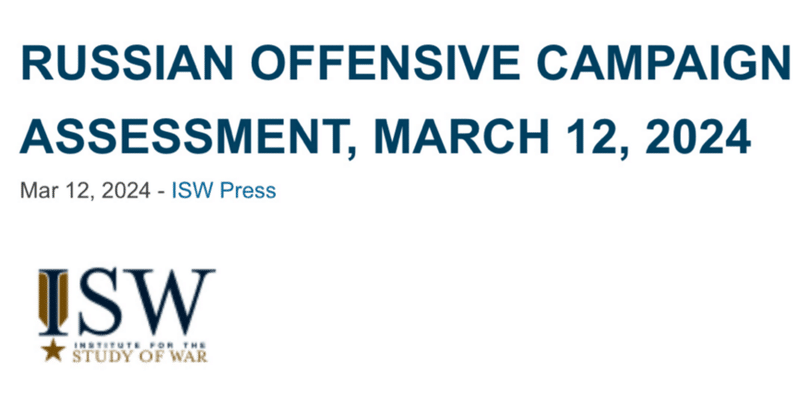
【抄訳】ISW ロシアによる攻勢戦役評価 2000 ET 12.03.2024 “ウクライナ・ロシア両軍のドローン・電子戦能力向上競争”
本記事は、戦争研究所(ISW)の2024年3月12日付ウクライナ情勢評価報告の一部を抜粋引用したうえで、その箇所を日本語に翻訳したものである。
ウクライナ・ロシア両軍のドローン・電子戦能力向上競争
報告書原文の引用(英文)
The New York Times (NYT) reported that Russian and Ukrainian forces have differential advantages and disadvantages in their electronic warfare (EW) capabilities. NYT reported on March 12 that Russian forces have more EW equipment but that Russian EW capabilities are spread out unevenly along the front and that Russian armored vehicles are vulnerable to Ukrainian drone strikes due to their lack of mounted EW equipment. The NYT stated that Russia’s defense industrial base (DIB) has adopted a “top down” approach to drone production with “heavy military oversight” that has made Russian drones “predictable” and lacking variety. This lack of variation has reportedly made it easier for Russian units to coordinate their drones’ flight paths and jammers so that they can jam Ukrainian drones without jamming their own. ISW has previously reported that the effectiveness of Russian EW systems is inconsistent across the front. Russian milbloggers have routinely complained about Russian forces’ lack of EW systems in the east (left) bank of Kherson Oblast, for example. Russian milbloggers have also recently criticized the Russian military command’s failure to properly equip Russian forces with drones and EW systems after an unsuccessful Russian mechanized assault near Novomykhailivka, Donetsk Oblast.
The NYT noted that Ukraine’s DIB, on the other hand, has allowed non-military companies to fund and supply drones to Ukrainian forces, which has allowed Ukrainian drone units to test different technologies, procurement processes, and combat missions on the battlefield. The NYT reported that a Ukrainian sergeant commanding a drone platoon stated that Ukrainian and Russian forces are engaged in a “constant arms race” in which one side improves its drone technology, forcing the other side to find a new way to combat this improvement. ISW has also previously reported that Ukraine has over 200 companies (most of which are privately owned) producing various drones for the Ukrainian military as of October 2023. Moscow Duma Deputy Andrei Medvedev recently stated that Russia has opted to mass produce drones, leading to the production of large numbers of drones that lack the technological adaptations needed to compete with Ukrainian drones. Medvedev noted that Ukrainian forces are constantly improving their drones. ISW has observed how recent Russian drone and missile strike packages are also characteristic of the constant air domain offense-defense innovation-adaptation race in which Russia and Ukraine are engaged. Ukrainian and Russian capabilities will likely vary across space and over time as one side will be unlikely to gain a decisive advantage across the entire frontline or permanently in one sector of the front. There will likely be opportunities to take advantage of these shifting variations.
日本語訳
ニューヨーク・タイムズ(NYT)紙は、ロシア・ウクライナ両軍が電子戦(EW)能力の面でお互いに異なった有利さと不利さを抱えていることを報じた。
3月12日のNYT紙報道によると、ロシア軍はかなり多くのEW装備を有してはいるものの、ロシア軍EW能力は前線上で不均一に広がっており、車載型EW装置の不足の結果、ロシア軍装甲車両はウクライナ軍のドローン攻撃に対して脆弱であるとのことだ。ロシアの国防産業基盤(DIB)はドローン生産に関して、「厳しい軍の監査」が伴う「トップダウン」式のアプローチを採用しており、このアプローチによって、ロシア製ドローンは「予測しやすいもの」なっており、種類の豊富さを欠くことになっていると、NYT紙は伝えた。一方で、バリエーションに欠くことは、ロシア軍部隊がドローンの飛行経路とジャミング装置を連携させることをいっそう容易にしており、その結果、ロシア軍は自軍ドローンをジャミングしてしまうことなしに、ウクライナ側ドローンのジャミングができている。ISWは以前、ロシア軍EWシステムの有効性は戦線全体でまだらな状態になっていることを伝えた。例えば、ロシア軍事ブロガーはヘルソン州東岸(左岸)のロシア軍にEWシステムが欠いていることへの不満を、定期的に述べている。ドネツィク州ノヴォミハイリウカ周辺でのロシア軍機械化部隊攻撃が不成功に終わったのちも、ロシア軍統帥部がドローンとEWをロシア軍部隊に適切に装備させられずにいることも、ロシア軍事ブロガーは最近、批判している。
それに対して、ウクライナのDIBは、国防産業に関わらない企業がウクライナ軍へのドローン供給やそれへの資金提供を行うことを許可しており、それによって、ウクライナ軍ドローン部隊はさまざまなテクノロジー・調達手順・戦場における戦闘任務をテストできている。NYT紙はドローン小隊を指揮するウクライナ軍の軍曹の発言を伝えており、それによると、ウクライナ軍とロシア軍は「絶え間ない兵器競争」に巻き込まれ、その競争のなかで、片方がドローン技術を向上させると、もう片方はこの能力向上に対抗する新たな方法を模索せざるを得なくなっているとのことだ。また、2023年10月の時点で、ウクライナ軍向けに各種ドローンを生産する企業が、ウクライナ国内で200社を超える(その大半は民間資本である)ことを、ISWはすでに報じている。モスクワ市議のアンドレイ・メドヴェージェフは最近、ロシアはドローン大量生産の道を選んでおり、その結果、ウクライナ軍ドローンと競合していくのに必要な技術的適応に欠くドローンを、大規模に生産することになっていると指摘した。メドヴェージェフは、ウクライナ軍が継続的にドローン能力を向上させていることにも触れている。最近、ロシア軍のドローン・ミサイル爆撃パッケージが、ロシア・ウクライナ双方が関わる、空中領域における絶え間ない攻防イノベーション・適応競争という性質を帯びている様子をISWは確認している。ウクライナ・ロシア両軍の能力は今後も場所や時の推移によってまちまちであると思われ、どちらかが戦線全域で決定的な優勢を確保できる、または、戦線上の一部で永続的に決定的な優勢を確保できることになる可能性は低いだろう。このような変化の移り変わりをうまく利用する好機が生じる可能性は高い。
この記事が気に入ったらサポートをしてみませんか?
